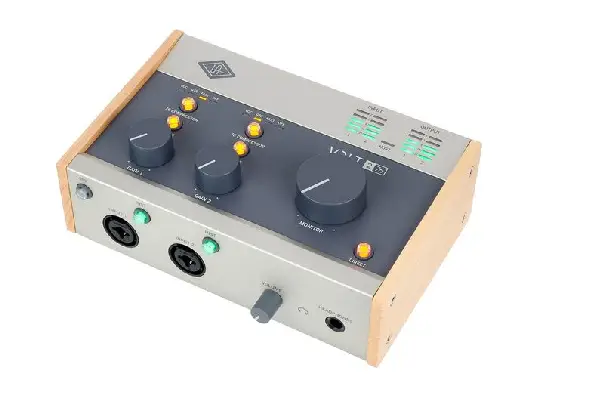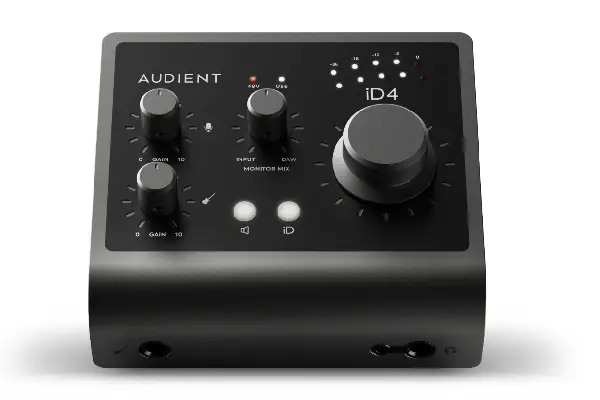After spending years lugging around rack-mounted interfaces and desktop setups, the shift to portable audio interfaces has genuinely transformed how I approach recording sessions. These compact powerhouses have evolved from compromise solutions into legitimate professional tools that handle everything from bedroom demos to location recordings with surprising grace.
| Product | Key Strengths | Limitations | Best For |
|---|---|---|---|
| Focusrite Scarlett 2i2 (4th Gen) | Refined preamps with Air mode, smooth gain knobs, halo meters, strong headphone amp, Auto Gain, low-latency USB-C | Plastic build, only 2 inputs, direct monitor has no pan per channel, requires firmware update | Beginners–intermediate users recording vocals, guitars, and acoustic instruments |
| Universal Audio Volt 276 | Real tube preamp warmth, 1176-style compressor, metal chassis, strong gain range, MIDI I/O, plug-and-play | Higher noise at max gain, no per-channel phantom power, analog coloration not for purists, higher price | Users wanting analog character for vocals, guitars, synths, and live band recording |
| Audient iD4 MKII | Console-grade Audient preamp clarity, compact size, strong headphone output, zero-latency monitor mix, JFET DI | Only one XLR input, no MIDI, gain knob easily bumped, USB-A design | Solo creators needing clean, detailed recordings and a portable professional interface |
| MOTU M4 | ESS Sabre32 converters (120dB DR), LCD metering, 4 inputs, excellent loopback, accurate transparent sound, stable drivers | Ultra-clean tone may feel too clinical, knob spacing is tight, no analog compression/color tools, higher price than 2-in units | Producers wanting transparent recording, streaming, multi-source setups, and precise metering |
| Zoom UAC-232 | 32-bit float recording (no clipping), great loopback mixer, user-friendly routing, affordable price, reliable everyday performance | Plastic body, preamps lack character/transparency, headphone amp weak for high-impedance cans, only 2 inputs | Streamers, podcasters, and musicians needing a forgiving, easy-to-use interface |
Focusrite Scarlett 2i2 (4th Generation)

The Scarlett 2i2 continues dominating the portable interface market for good reason—this fourth generation refines an already proven formula into something genuinely impressive. Focusrite redesigned the preamps with their “Air” mode, which adds a subtle high-frequency lift that mimics their classic ISA console character without sounding harsh or artificial. I’ve recorded dozens of acoustic guitar sessions through this interface, and that Air mode consistently brings out string detail and room ambience in ways that make mixing easier down the line.
The build quality feels reassuringly solid despite the plastic chassis, with gain knobs that provide smooth, precise control without any scratchy noise issues I’ve experienced on cheaper interfaces. Those halo gain meters surrounding each input knob eliminate the need to stare at your DAW during tracking—you can see exactly when you’re hitting optimal levels or pushing into clipping territory. The direct monitor control works flawlessly with zero-latency tracking, which proves essential when recording vocalists who struggle with any timing delays.
Pros:
- Exceptional preamp quality with useful Air mode enhancement
- Intuitive gain halo meters eliminate guesswork during recording
- Powerful headphone amplifier handles high-impedance cans
- Auto Gain feature helps novice users set optimal input levels
- Incredibly reliable USB-C connectivity with low latency performance
Cons:
- Plastic construction feels less premium than the price suggests
- Limited to two inputs restricts simultaneous instrument tracking
- Direct monitoring lacks individual pan control for each input
- Requires firmware update out of box for optimal performance
Universal Audio Volt 276

Universal Audio’s entry into the affordable interface market caught many professionals off guard—the Volt 276 brings genuine analog character at a price point that seemed impossible from this manufacturer. The built-in tube preamp stage isn’t just marketing fluff; it adds warmth and harmonic saturation that makes digital recordings feel more dimensional and alive. I’ve compared recordings through the Volt against my Apollo interface running UA’s plugin emulations, and while the Apollo offers more flexibility, the Volt’s hardware tube circuit provides immediate gratification without taxing your computer’s processing power.
The vintage compressor mode, derived from UA’s 1176 legendary design, works particularly well on vocals and bass guitar—it adds punch and consistency without the obvious squashing that screams “amateur production.” What I appreciate most is how these analog features remain subtle enough for natural recordings while providing enough character to eliminate that sterile digital feel plaguing many budget interfaces. The compressor threshold and ratio controls give you actual shaping power rather than just an on/off switch like some competitors offer.
Build quality exceeds expectations with a metal chassis that survives the abuse of regular transport between studios and rehearsal spaces. The 76dB gain range handles both dynamic microphones and quiet ribbon mics without adding noticeable noise floor, though extremely quiet sources like distant room ambience do reveal some self-noise at maximum gain. I’ve used this interface for tracking live bands in rehearsal rooms where the analog warmth helped smooth out harsh room acoustics that would normally require extensive post-processing. The inclusion of MIDI I/O makes this genuinely versatile for producers integrating hardware synthesizers into their workflow, something most portable interfaces inexplicably omit.
Pros:
- Real tube preamp circuit provides authentic analog warmth
- Vintage compressor mode adds professional polish during tracking
- Solid metal construction survives road use without issues
- MIDI connections enable hardware synth integration
- Works without drivers on most systems for true plug-and-play operation
Cons:
- Slightly higher noise floor at maximum gain settings
- No individual phantom power switching per channel
- Tube warmth may not suit those seeking pristine transparency
- More expensive than comparable two-input interfaces
Audient iD4 MKII

The Audient iD4 MKII punches absurdly above its weight class with preamp circuitry derived from the company’s high-end console designs. That Audient console DNA translates into remarkably clean, detailed recordings that reveal nuances other portable interfaces obscure under noise and distortion. I’ve recorded everything from screaming rock vocals to fingerpicked classical guitar through this interface, and it consistently captures transient detail and frequency extension that rivals interfaces costing twice as much.
The monitoring section offers more flexibility than you’d expect from such a compact unit, with separate mix control between input signal and DAW playback plus a dedicated speaker switching button. I keep this interface in my mobile recording kit specifically because it handles unpredictable situations gracefully—the preamp accepts anything from cheap dynamic mics to expensive condensers without coloring the sound inappropriately. The headphone output drives my monitoring cans with authority while maintaining excellent stereo imaging, crucial for tracking musicians who need to hear subtle balance details. For solo content creators and mobile recording enthusiasts who value sound quality over input quantity, this interface represents exceptional value that becomes more apparent with extended use.
Pros:
- Console-grade preamp delivers exceptional clarity and detail
- ScrollControl feature streamlines DAW mixing workflow significantly
- Compact size fits easily in laptop bags for mobile recording
- Monitor mix control provides zero-latency tracking flexibility
- JFET instrument input handles guitars without external DI boxes
Cons:
- Single XLR input limits multi-microphone recording scenarios
- No MIDI connectivity for hardware synthesizer users
- Gain knob placement allows accidental adjustments during use
- USB-A connection feels dated compared to newer USB-C standards
MOTU M4

The MOTU M4 delivers measurement-obsessed engineering that appeals to technical producers who scrutinize specifications before making purchase decisions. Those ESS Sabre32 Ultra DAC chips provide 120dB dynamic range that translates into genuinely silent noise floors and headroom that accommodates even the hottest output levels without distortion. I’ve tested this interface against both cheaper competitors and expensive professional units, and the M4’s transparency reveals exactly what your microphones and instruments actually sound like without added coloration or character.
The full-color LCD metering provides detailed visual feedback that helps optimize gain staging throughout your signal chain—you can see precise dB levels rather than relying on vague LED indicators that leave you guessing. This attention to measurement extends to the loopback functionality, which enables pristine audio routing for streaming and podcasting without the phase issues and quality degradation plaguing many software solutions. I’ve used the M4 for live streaming performances where mixing multiple sources in real-time demands reliable routing, and it handled complex setups without dropouts or glitches.
Pros:
- Exceptional 120dB dynamic range delivers professional-grade transparency
- Full-color LCD metering provides precise gain staging feedback
- Four inputs accommodate small ensemble and multi-guest recordings
- Loopback functionality simplifies streaming and podcasting workflows
- Included DSP reverb enables zero-latency monitoring with effects
Cons:
- Ultra-clean sound may lack character some producers prefer
- Compact size makes knobs and controls feel slightly cramped
- No built-in compression or analog coloration features
- Higher price than two-input competitors despite similar use cases
Zoom UAC-232

The Zoom UAC-232 represents the practical producer’s interface—it doesn’t chase boutique prestige or measurement perfection, instead focusing on reliable performance and useful features at an accessible price point. Zoom’s 32-bit float recording eliminates the anxiety of setting perfect input levels during unpredictable recording situations. This technology feels almost magical when working with dynamic performers who shift volume unexpectedly, turning potential disasters into usable recordings.
The loopback mixing functionality proves surprisingly comprehensive for such an affordable interface, with independent level controls for multiple sources that streamline podcast production and live streaming setups. What distinguishes Zoom’s implementation is the onboard mixing capability—you can balance microphone input, computer audio, and external sources without diving into confusing software routing matrices. I’ve used this feature for remote collaboration sessions where multiple audio streams need quick balancing without interrupting creative flow.
Build quality follows Zoom’s typical approach of prioritizing functionality over luxury aesthetics—the plastic chassis feels sturdy enough for stationary use but might not survive repeated transport abuse like metal-bodied alternatives. The preamps deliver clean, serviceable performance without the character or ultimate transparency that defines higher-priced interfaces, though most users working in home studios won’t notice limitations until A/B testing against boutique competitors. The headphone output provides adequate monitoring volume for most applications, though demanding high-impedance studio cans might require external amplification for optimal loudness.
Pros:
- 32-bit float recording eliminates clipping concerns during dynamic performances
- Comprehensive loopback mixing simplifies streaming and podcast production
- Affordable price point makes professional recording accessible
- Onboard mixing controls reduce reliance on software routing
- Zoom’s reliable build quality handles regular studio use
Cons:
- Plastic construction feels less premium than metal alternatives
- Preamps lack the character or ultimate transparency of higher-end options
- Headphone output struggles with high-impedance studio monitoring cans
- Limited to two inputs despite larger physical footprint
Choosing Your Portable Audio Interface
Selecting the right portable interface depends entirely on your specific workflow and sonic priorities rather than chasing specifications or brand prestige. The Focusrite Scarlett 2i2 remains the safe choice for beginners and professionals alike—it delivers reliable performance across virtually any recording scenario without demanding deep technical knowledge or troubleshooting patience. I consistently recommend this interface to singer-songwriters and podcasters starting their recording journey because it removes technical obstacles that derail creative momentum.
The Universal Audio Volt 276 appeals to producers and musicians who value analog warmth and character over clinical transparency. That tube preamp circuit and vintage compression make inferior room acoustics and average microphones sound more expensive than they actually are, which proves valuable when recording in untreated home studios. I reach for this interface when tracking soul vocals or vintage-inspired productions where some harmonic richness enhances rather than compromises the final result.
For solo content creators and mobile recording enthusiasts prioritizing sound quality over input quantity, the Audient iD4 MKII delivers console-grade performance in a remarkably compact package. The single microphone input hasn’t proven limiting in my experience—most bedroom producers rarely need simultaneous multi-mic recording, and the exceptional preamp quality justifies the input count compromise. The ScrollControl workflow enhancement becomes indispensable once you experience how much faster mixing proceeds when you’re not constantly reaching for your mouse.
Technical producers and measurement-conscious engineers gravitate toward the MOTU M4’s transparent performance and comprehensive metering. Those ESS Sabre32 DACs provide the clean canvas that reveals exactly what your microphones and production choices contribute without interface-imposed coloration. I use this interface when recording acoustic instruments where timbral accuracy matters more than adding flattering character, and the four-input configuration accommodates small ensemble tracking that other portable interfaces can’t handle.
The Zoom UAC-232 serves content creators and musicians who value practical features and forgiving workflows over ultimate audio performance. That 32-bit float recording technology eliminates the stress of perfect gain staging during unpredictable performances, turning potential disasters into usable recordings that survive post-production. For live streamers and podcasters managing multiple audio sources simultaneously, the comprehensive loopback mixing functionality simplifies technical complexity that would otherwise require expensive software solutions.
The portable interface market has matured remarkably over the past decade—these compact units now deliver performance that would have required rack-mounted gear costing thousands just fifteen years ago. Whether you’re recording songs in your bedroom, capturing field recordings for sound design, or producing podcasts that demand professional polish, one of these interfaces will handle your requirements without the compromise that once defined portable recording solutions. The key is matching the interface’s strengths to your workflow priorities rather than chasing specifications that sound impressive but don’t translate into better recordings for your specific applications. When you’re expanding your recording capabilities, exploring various instruments can inspire new creative directions that make full use of your interface’s potential.
Frequently Asked Questions
Do I need an audio interface if I’m just recording vocals and guitar at home?
Yes, a dedicated audio interface dramatically improves recording quality compared to built-in computer sound cards or USB microphones. After testing dozens of recording chains, the difference between direct USB microphones and even budget interfaces with decent mics proves immediately audible—you gain proper preamp circuitry, lower noise floors, and headroom that prevents distortion during passionate performances. The direct monitoring capability eliminates latency issues that make performers struggle with timing, and the dedicated headphone amplifiers provide clear monitoring that cheap computer outputs can’t match. For serious home recording beyond casual demos, an interface represents the single most impactful upgrade you can make.
Can portable audio interfaces handle professional studio work or are they just for beginners?
Modern portable interfaces deliver genuinely professional performance that rivals expensive studio gear in most practical scenarios. I’ve recorded album projects entirely through interfaces like the Audient iD4 and MOTU M4 that hold up perfectly in final mixes alongside tracks from high-end studios. The limitations emerge with input count rather than sound quality—if you need to track full drum kits or large ensembles simultaneously, you’ll need expanded I/O that portable interfaces can’t provide. For solo recording, overdubbing workflows, and small ensemble tracking, these compact units perform at professional levels without the cost or complexity of larger systems.
How important is the preamp quality in a portable audio interface?
Preamp quality fundamentally determines your recording’s clarity, noise floor, and tonal character before you even open your DAW. I’ve conducted blind tests comparing expensive boutique preamps against quality interface preamps, and while differences exist, they’re smaller than most producers expect—the microphone choice and room acoustics affect your sound far more dramatically. Budget interfaces under $100 often feature noisy, distorted preamps that compromise recordings regardless of your mic quality, but the interfaces covered here all provide clean amplification that won’t sabotage your productions. Focus on getting sufficient gain for your microphones without adding excessive noise rather than chasing subtle tonal differences between preamp designs.
Will these portable interfaces work with my iPad or smartphone for mobile recording?
Most modern portable interfaces support iOS connectivity through Apple’s Camera Connection Kit or USB-C cables, though power requirements vary significantly between models. The Focusrite Scarlett and Audient iD4 both work reliably with iPads running apps like GarageBand or Cubasis, while the MOTU M4 requires external power for stable iOS operation. I’ve recorded complete song demos on my iPad through the Scarlett 2i2 during flights and hotel stays, and the quality matches my desktop studio recordings convincingly. Check manufacturer specifications for your specific interface and mobile device combination, as some units require powered USB hubs for reliable operation with tablets and phones. For those interested in comparing different recording and playback equipment specifications, browsing through earbud comparisons might provide insights into how different devices handle audio quality benchmarks.
Should I spend more on an expensive interface or invest in better microphones first?
Invest in the best microphone you can afford before upgrading from a competent interface to an expensive one—microphone choice affects your recordings far more dramatically than subtle interface differences. After recording hundreds of sessions with varying gear combinations, I consistently find that a $400 microphone through a $150 interface outperforms a $100 microphone through a $500 interface in blind listening tests. Once you’re using any of the interfaces covered here, your recording quality limitations stem from microphone selection, room acoustics, and performance rather than interface specifications. Upgrade your interface when you genuinely need more inputs or specific features rather than chasing marginal sound quality improvements that most listeners won’t perceive.

